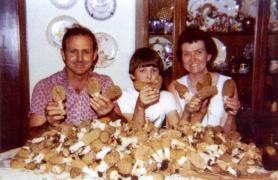
When Steve Phillips talks about improving turkey habitat on his land, it’s hard to tell what excites him more — the journey or the goal.
“I’ll be depressed if I ever get to the point where I can’t make this better,” he said as he drove across the property that has caused the retired furniture retailer to fall in love with a different type of home improvement. “Hummingbird Farm” is the charming name Phillips has given his 404-acre patch of
property in eastern Callaway County, but improving living conditions for a larger bird — the eastern wild turkey — has been the focus of much of the work he has done on the land.
And his work is far from over.
“I’m just scratching the surface of what I could be doing here,” he said with his ever-present smile. This type of visionary verve about habitat work on privately owned land is key to the future of wild turkeys in the Show-Me State and is a core component of MDC’s Wild Turkey Habitat Initiative. This multi-year, multi-faceted project is designed to:
- Increase, among MDC staff and land managers, the understanding of the characteristics of and how to create quality brood-rearing habitat.
- Evaluate where and how much of MDC-managed lands are currently providing quality brood-rearing habitat. Identify where habitat management can be improved and revise management plans to allow for improved habitat management.
Every Acre Matters
While a portion of these objectives focus on public land, much of the initiative’s emphasis will be on the acres in Missouri that are in private ownership. The efforts to engage private landowners, landowner cooperatives, and partner organizations are essential if the initiative is to have a positive impact on turkey habitat on a large scale in the state.
“The quantity of usable acres of nesting and brood rearing habitat on private land will, ultimately, be what makes a difference to the wild turkey population,” said Nick Oakley, MDC wild turkey and ruffed grouse biologist. “MDC land can and should function as a proving ground and training location for land management techniques, as well as a great place for public land hunting, but over 93 percent of land in Missouri is privately held, so quality habitat needs to exist there as well.”
MDC has always recognized and appreciated the roles Missouri’s farmers, ranchers, and landowners have played in establishing and maintaining the state’s turkey population. One of the most important things MDC wants landowners to remember is that their roles are important, no matter how big or small their acreages are.
“Every little bit helps and doing anything is better than doing nothing,” said Oakley. “Small, incremental improvements across the landscape will result in a mosaic of quality habitat that doesn’t need to fall on any one landowner. Turkeys have seasonal requirements that likely can’t be met on a single piece of property anyway, so every acre of improved habitat makes a big difference when viewed collectively.”
The Challenges
This is especially true in a 21st century Missouri where the state’s turkey population of an estimated 350,000 birds is facing a multitude of challenges brought about by changes to the landscape and weather patterns. Sadly, the challenges faced by Missouri’s turkeys are part of a much larger troubling trend occurring over much of the U.S.
“Eastern turkeys (the wild turkey sub-species found in Missouri and elsewhere throughout much of the eastern and central U.S.) are in decline throughout nearly their entire range for a variety of reasons,” said John Burk, a district biologist with the National Wild Turkey Federation. “According to turkey researcher Dr. Michael Chamberlain, the decline averages about 16 percent nationally from the high-water mark of the early 2000s. In some areas it is more severe than others.”
Burk said many of the obstacles facing Missouri’s turkeys are also posing problems elsewhere in the U.S.
“A lot has changed since the early 2000s,” he said. “These changes include wetter than historically normal springs for most of the last 14 years, CRP (Conservation Reserve Program) acres, which provide nesting and brood-rearing habitat, are roughly half of what they were during peak years. Other problems? High predator populations (that prey on both nests and poults), decreased insect abundance, increased prevalence of invasive plant species … to name just a few.”
The Opportunities
However, all is not gloom for gobblers and those who like to hunt them or hear them. While it’s true that terrestrial changes are one of the challenges wild turkeys face today, it’s equally true these birds have demonstrated a certain amount of habitat flexibility. Biologists say the key is to reward this resilience with good habitat.
“Turkeys are well adapted to their environment,” said Oakley. “If we can manage land in a way that gives them an advantage, they will be able to put it to good use.”
Burk agrees.
“In the late 1990s and early 2000s when turkey numbers were peaking, people with marginal habitat got used to hearing, hunting, and harvesting gobblers because turkey populations on ‘the good stuff’ exceeded carrying capacity and expanded out to those marginal areas,” he said. “Therefore, if you want it to be like the good old days, you have to make your property qualify as ‘the good stuff’ to the gobblers you want using it.”
Bringing the “good stuff” to Hummingbird Farm is a primary goal for Phillips. His residence is still in Kirkwood, but it’s clear his heart is in Callaway County. Habitat work he has done on his property include timber stand improvement (TSI) work, edge-feathering, and prescribed fire. Some of the open ground on his land is filled with prairie plantings that include native wildflowers and grasses while other open areas feature food plots. More than 300 trees have also been planted on the property. Phillips’ habitat work has been a journey that has involved learning as well as labor.
“I knew I had a lot of learning and work to do,” Phillips said, recalling when he first purchased the land in 2015. “I’m a voracious reader so I gleaned a lot of information from the Missouri Conservationist magazine, from habitat books and, of course, from Jordon.”
Jordon is Jordon Beshears, a former MDC private land conservationist, recently promoted to district supervisor, who has worked with Phillips on his land from the outset. He said there are various components to turkey habitat, but the ingredient most-needed for all of them to be effective is patience.
“Similar to managing for other wildlife species, it takes time to improve turkey habitat,” Beshears said. “Woodland restoration, for example, is usually a multi-year process. It may take years to turn previously unmanaged woods to restored woodland, but each step along the way creates better habitat.”
Mutually Beneficial
What’s good for turkeys can also help crops and cattle. One of the points MDC’s Wild Turkey Habitat Initiative wants to make is that turkey habitat management and agriculture can not only coexist — in many cases it can be mutually beneficial.
“Farming and turkey habitat can absolutely go together,” Beshears said. “In row-crop operations, practices like no-till farming, planting cover crops, diversifying crop rotations, and simply not mowing idle areas or old fields during the nesting and brooding season can benefit turkeys.
“Livestock producers can improve production and turkey habitat at the same time, as well,” he continued. “Rotational grazing, incorporating legumes, native grasses, and forbs into pastures, and excluding livestock access to woodlands can all pay dividends, both in turkey habitat and in livestock production.”
In some cases, financial assistance is available for qualifying landowners looking to improve habitat on their land.
“MDC and USDA have programs to help offset the cost of implementing practices that will increase both habitat and the landowner’s bottom line,” Beshears said. Practices that frequently have cost-share options include pollinator plantings, timber stand improvement work, prescribed burning, native grass pasture plantings, legume inter-seeding, exclusion fencing for woodland areas, and cover crops.
Working Together
Phillips’ property is the largest part of the Bachelor Creek Habitat Cooperative — a group of nine adjacent landowners who have turned habitat management into a collaborative undertaking. Beshears said a shared-effort approach to habitat improvement helps wild turkeys and the participating landowners.
“Turkeys have relatively large home ranges that often cross multiple properties,” he said. “When landowners make a collaborative effort and get involved in a focused way so that they make an impact on a larger landscape, they will find it’s easier to reach their common goals. Though it’s a collaborative effort, each individual landowner will benefit from the actions of the group.”
Phillips said the praise for what’s been accomplished on his property should be shared by Beshears and by his neighbor, Marvin Cobb.
“Every year I sit with Jordon, and we develop a to-do list for that fiscal year,” he said. “Jordon takes care of the paperwork and Marvin and I do the work on the land. I could not do this without Jordon and Marvin.”
Phillips said his wife, Susan, has been a key partner, too.
“I also have to thank my wife, who tolerates all the time, the expense, and the passion that I put into this,” he said. “I don’t think she gets why I love this so much, but she loves that I get it.”
Turkeys may be near the top of Phillips’ list, but his habitat work is about more than helping one of Missouri’s top gamebirds. He knows his labors are helping many species. Providing better habitat for multiple species is another benefit of the Missouri Wild Turkey Habitat Initiative.
“Good turkey habitat is good deer and rabbit habitat, it is good hummingbird and pollinator habitat, and so on,” said Oakley. “Managing for turkeys can even improve soil, water, and timber quality. These improvements benefit every Missourian, not only the wild turkey and those of us who enjoy it.”
When Phillips looks across his property, he not only envisions turkeys reaping the benefits of his habitat work in the future. He also sees family members enjoying the land.
“I truly believe that landowners have a responsibility to do whatever they can to help to make their land better than they found it,” he said. “I do all this work because my mission is to pass this farm on to my family in the best possible condition for their enjoyment.”
















Also In This Issue

Celebrating 70 years of hunting the favored fungi.

Practical tips for hitting the ground running.
And More...
This Issue's Staff
Editor - Angie Daly Morfeld
Associate Editor - Larry Archer
Photography Editor - Cliff White
Staff Writer - Kristie Hilgedick
Staff Writer - Joe Jerek
Staff Writer – Dianne Van Dien
Designer - Shawn Carey
Designer - Marci Porter
Photographer - Noppadol Paothong
Photographer - David Stonner
Circulation - Laura Scheuler






















